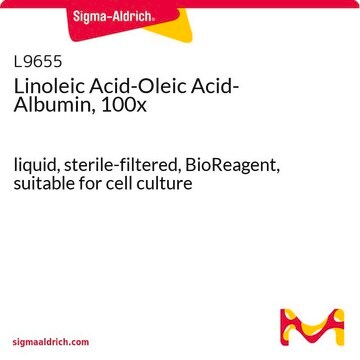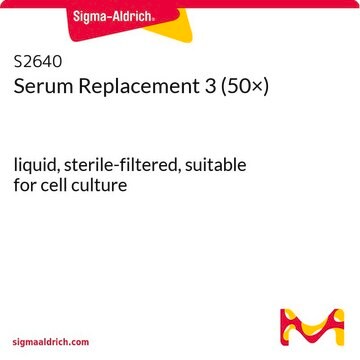S4920
SITE Liquid Media Supplement (100×)
liquid, sterile-filtered, BioReagent, suitable for cell culture
Synonym(s):
Media supplement
Sign Into View Organizational & Contract Pricing
All Photos(1)
About This Item
UNSPSC Code:
12352205
NACRES:
NA.75
Recommended Products
sterility
sterile-filtered
Quality Level
product line
BioReagent
form
liquid
technique(s)
cell culture | mammalian: suitable
impurities
endotoxin, tested
shipped in
ambient
storage temp.
2-8°C
General description
SITE Liquid Media Supplement (100×) serves as a substitute for serum-free formulations. It contains purified factors required for in vitro growth and differentiation studies. The addition of supplements to media will vary, depending on the cell type being studied and the basal medium employed. It is a general cell supplement designed for use in non-complex media (e.g., minimum essential medium (MEM), Roswell Park Memorial Institute Medium (RPMI-1640)) and complex media (e.g., Ham′s F-12, Dulbecco′s Modified Eagle Medium (DME) /F-12, MEM) with sodium pyruvate.
Application
SITE Liquid Media Supplement (100×) has been used:
- in the 3D culture of mouse embryonic pancreatic epithelial cells
- to isolate rabbit gastric glands and parietal cells
- to isolate rabbit single proximal tubule cells
Biochem/physiol Actions
- Insulin: a polypeptide hormone that promotes the uptake of glucose and amino acids and may owe an observed mitogenic effect to this property.
- Transferrin: an iron-transport protein. Iron is an essential trace element but can be toxic in its free form. To nourish cells in culture, iron is supplied bound to transferrin in serum.
- Selenium: an essential trace element normally provided by serum.
- Ethanolamine: plays a significant role in the proliferation of hybridoma cells and frequently is added to supplements used for culturing these cells.
Components
Contains 1.0mg/ml recombinant human insulin, 0.55mg/ml human transferrin (substantially iron-free), 0.5μg/ml sodium selenite and 0.2mg/ml ethanolamine at the 100x concentration.
Preparation Note
Prepared in Earle′s Balanced Salt Solution (EBSS) without phenol red.
Storage Class Code
12 - Non Combustible Liquids
WGK
WGK 1
Flash Point(F)
Not applicable
Flash Point(C)
Not applicable
Certificates of Analysis (COA)
Search for Certificates of Analysis (COA) by entering the products Lot/Batch Number. Lot and Batch Numbers can be found on a product’s label following the words ‘Lot’ or ‘Batch’.
Already Own This Product?
Find documentation for the products that you have recently purchased in the Document Library.
Customers Also Viewed
Lixin Zhu et al.
American journal of physiology. Cell physiology, 295(1), C192-C202 (2008-05-16)
In a comparison of three different tissues, the membrane cytoskeleton linker protein ezrin was found to assume high levels of phosphorylation on threonine-567 (T567) in the brush border membranes of renal proximal tubule cells and small intestine enterocytes, in contrast
H Murakami et al.
Proceedings of the National Academy of Sciences of the United States of America, 79(4), 1158-1162 (1982-02-01)
A serum-free medium supplemented with a few growth factors was devised to grow lymphocyte hybridomas. The medium was developed with the hybridoma line MPC11-BL, a fusion product between a mouse plasmacytoma cell line (MPC11TG70na3) and mouse (BALB/c) spleen cells. In
Lixin Zhu et al.
American journal of physiology. Cell physiology, 293(3), C874-C884 (2007-06-08)
In its dormant state, the membrane cytoskeletal linker protein ezrin takes on a NH(2) terminal-to-COOH terminal (N-C) binding conformation. In vitro evidence suggests that eliminating the N-C binding conformation by Thr(567) phosphorylation leads to ezrin activation. Here, we found for
Nico Laur et al.
PloS one, 15(5), e0233357-e0233357 (2020-05-21)
Trace elements and minerals are compounds that are essential for the support of a variety of biological functions and play an important role in the formation of and the defense against oxidative stress. Here we describe a technique, allowing sequential
Gisela Wilcox
The Clinical biochemist. Reviews, 26(2), 19-39 (2005-11-10)
As obesity and diabetes reach epidemic proportions in the developed world, the role of insulin resistance and its consequences are gaining prominence. Understanding the role of insulin in wide-ranging physiological processes and the influences on its synthesis and secretion, alongside
Our team of scientists has experience in all areas of research including Life Science, Material Science, Chemical Synthesis, Chromatography, Analytical and many others.
Contact Technical Service











